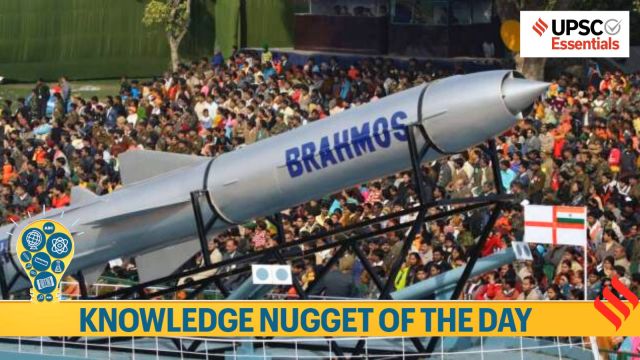
Why in the news?
Stating that BrahMos missile launched from Sukhoi-30 MKI was the primary offensive weapon used during Operation Sindoor, chairman of the Defence Research and Development Organisation (DRDO) Samir V Kamat said on Saturday (9th August) that the development of a smaller version of the supersonic cruise missile, BrahMos-NG, will soon begin.
Story continues below this ad
Furthermore, India’s BrahMos supersonic cruise missiles were delivered to the Philippines on April 19, as part of a $375 million deal signed by the two countries in 2022. In this context, it becomes essential to know about the BrahMos missiles.
Key Takeaways :
1. BrahMos is an extremely versatile stand-off range ‘fire-and-forget’ type supersonic cruise missile that has proved its capabilities in land-based, ship-based, air launched and submarine-based versions.
2. These supersonic cruise missiles are operationalised in all three defence services. It is built by BrahMos Aerospace, a joint venture between India’s Defence Research and Development Organisation (DRDO) and Russia’s NPO Mashinostroyeniya.
3. BrahMos is a two-stage missile with a solid propellant booster engine. Its first stage brings the missile to a supersonic speed, greater than the speed of sound, and it then gets separated. The second stage of the liquid ramjet then fires and thrusts the missile to three times the speed of sound in its cruise phase. A liquid ramjet is an air-breathing jet engine that uses liquid fuel, which is injected into the high-speed airstream and ignited to produce thrust.
Story continues below this ad
4. The missile has an extremely low radar signature, making it stealthy, and it can follow a variety of paths. As per its website, cruising altitude could be up to 15 km and terminal altitude as low as 10 metres. The missile carries a conventional warhead weighing 200-300 kg.
5. Cruise missiles, like the BrahMos, come under the category known as the “stand-off range weapons”, which are fired from a range sufficient to allow the attacker to evade defensive fire from the adversary. These weapons are in the arsenal of most major militaries in the world.
6. The versions of the BrahMos that are currently being tested at an extended range can hit targets at upto 350 kilometres, as compared to its original range of 290 kilometres. Even higher ranges of upto 800 kilometres, and hypersonic speed or five times the speed of sound, are said to be on the cards.
7. Compared to subsonic cruise missiles, the BrahMos has three times the speed, 2.5 times the flight range and a higher seeker range, leading to higher accuracy and nine times more kinetic energy.
Story continues below this ad
Variants of BrahMos
Following the first successful launch at the Chandipur test range, the BrahMos was inducted into the Navy in 2005, into the Indian Army in 2007 and the first successful flight with IAF’s Sukhoi-30 MKI fighter in 2017. While land, air, sea and submarine are broader classifications of the missile, numerous versions with extended ranges and evolving sensing capabilities have been tested and deployed over the last 24 years.
1. Ship-based variant: The naval version can be fired vertically or inclined, and from both moving and static naval platforms. From ships, the BrahMos can be launched as a single unit or in a salvo of upto eight, separated by two-and-a-half-second-long intervals. These salvos can hit and destroy a group of frigates having modern missile defence systems. BrahMos is a ‘prime strike weapon’ for such targets and significantly increases the capability of engaging naval surface targets at long ranges.
The Indian Navy began inducting BrahMos on its frontline warships from 2005, and it can hit sea-based targets beyond the radar horizon. Indian Navy’s guided missile destroyer INS Rajput was the first ship to deploy a BrahMos and it has since been deployed on other warships.
2. The land-based system: The land-based BrahMos Complex has four to six mobile autonomous launchers. Each launcher has three missiles on board that can be fired almost simultaneously on three different targets and in different configurations. Multiple units of BrahMos systems have been deployed along India’s land borders.
Story continues below this ad
The land attack version of the BrahMos, with a capability of cruising at 2.8 Mach speed. Following upgrades, it can hit targets at a range of upto 400 kilometres with precision. The development of advanced versions of a range above 1,000 kilometres and speed upto 5 Mach is said to be in store. The ground systems of BrahMos come with an air-conditioned cabin with Nuclear, Biological and Chemical (NBC) protection. The land attack version of the BrahMos was operationalised in the Indian Army in 2007.
3. Air-launched version: The BrahMos Air Launched Cruise Missile (ALCM) is the heaviest missile to arm India’s frontline fighter jet, the Sukhoi-30 MKI. In November 2017, BrahMos was successfully flight-tested for the first time from the IAF frontline fighter aircraft against a sea-based target in the Bay of Bengal and has since been successfully tested multiple times. In tests conducted in 2019, BrahMos ALCM validated its land attack and anti-ship capability from large, stand-off ranges by day or night and in all weather conditions.
4. Submarine-launched version: This version can be launched from around 50 meters below the surface of the water. The canister-stored missile is launched vertically from the pressure hull of a submarine and uses different settings for underwater and out-of-the-water flights. This version was first successfully tested in March 2013 from a submerged platform off the coast of Visakhapatnam.
5. Futuristic BrahMos-NG: Development is underway for a futuristic version of the BrahMos, known as the BrahMos-NG (Next Generation), primarily for air and naval applications. This version will have reduced dimensions and weight, next generation stealth features, greater effectiveness against Electronic counter-countermeasure (ECCM), higher versatility for underwater combat and launch capability from a torpedo tube.
Story continues below this ad
BEYOND THE NUGGET: Pralay quasi-ballistic missile
1. The Defence Research and Development Organisation (DRDO) conducted two consecutive successful tests of quasi-ballistic missile Pralay from Dr APJ Abdul Kalam island off the coast of Odisha on 28th and 29th July. Three Pune based facilities of the DRDO have played a key role in the development of the tactical weapons system.
2. “Pralay is an indigenously-developed solid propellant quasi-ballistic missile employing state-of-the-art guidance and navigation to ensure high precision. The missile is capable of carrying multiple types of warheads against various targets.” said the Ministry of Defence.
3. The first test of Pralay (which means widespread destruction) was conducted in December 2021. The missile is slated to be armed with a conventional warhead and will be inducted into the artillery of the Indian Army.
4. The system has been developed by Hyderabad-based DRDO facility Research Centre Imarat in collaboration with other facilities including three Pune based firms—Armament Research and Development Establishment (ARDE), High Energy Materials Research Laboratory (HEMRL) and Research & Development Establishment, Engineers (R&DE).
Story continues below this ad
- 01
What are ballistic missiles?
The ballistic missiles are a category of missiles that utilise projectile motion to deliver warheads. During their arched trajectories, the ballistic missiles are powered during their initial travel but later take a gravity driven path.
- 02
What are quasi-ballistic missiles?
The quasi ballistic missiles are a class of missiles that have low trajectory and take the ballistic trajectory but can change course and make maneuvers during the flight if required.
- 03
What is the difference between ballistic missiles and cruise missiles?
Ballistic missiles use projectile motion to deliver warheads to a target. They are powered for a relatively brief time, after which they let the laws of physics take them to their target. These missiles are categorised based on range. Ballistic missiles can carry either nuclear or conventional warheads. Examples of ballistic missiles are Agni I, Agni II, Prithvi I, Prithvi II and Dhanush missiles.
Cruise missiles are unmanned vehicles powered by jet engines that can be launched from ground, air, or sea platforms. Examples of cruise missiles are BrahMos,Tomahawk,Kalibr, AGM-86 ALCM and JASSM.
The cruise missiles fly at a low distance from the ground while the ballistic missiles follow a parabolic trajectory. Ballistic missiles are easier to track since they have a standard parabolic trajectory, as compared to cruise missiles which can fox air defence systems due to their manoeuvrability.
Post Read Questions
(1) With reference to the BrahMos missile, consider the following statements:
1. It is a two-stage missile with a solid propellant booster engine.
2. The missile has a very low radar signature which makes it stealthy.
3. The course of the missile cannot be altered once fixed.
Story continues below this ad
4. There is no sea to sea variant of BrahMos missile.
How many of the statements given above are correct?
(a) Only one
(b) Only two
(c) Only three
(d) All four
(2) With reference to the Pralay missile, consider the following statements:
1. It is an indigenously developed solid propellant quasi-ballistic missile.
2. This missile is capable of carrying multiple types of warheads against various targets.
3. The first test of Pralay was conducted in 2024.
How many of the statements given above are correct?
(a) Only one
(b) Only two
(c) All three
(d) None
Subscribe to our UPSC newsletter. Stay updated with the latest UPSC articles by joining our Telegram channel – Indian Express UPSC Hub, and follow us on Instagram and X.
🚨 Click Here to read the UPSC Essentials magazine for July 2025. Share your views and suggestions in the comment box or at manas.srivastava@indianexpress.com🚨



































